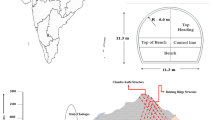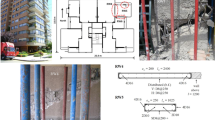Abstract
Current study deals with investigating the effects of both time factor and the selection of a constitutive model type on predicting deformations of an excavation braced by nailing using two and three-dimensional finite element analyses. In addition, the effects of stress path and the type of defined initial conditions of the analytical model on deformations of the floor and walls of the excavation are also studied. Time factor, in the form of earth materials’ creep, can largely be entered into calculation of deformations of excavations by conducting viscoelastic and viscoplastic analyses. On the other hand, there hasn’t been done a comprehensive study regarding the creep behavior of excavations through comparing the results of two-dimensional and three-dimensional numerical analyses so far. The results showed that it’s largely possible to approach the actual deformation behavior of an excavation by considering the constitutive model of soft soil creep, SSC model, in the numerical plastic analyses. The effects of stress path on the deformation behavior of the excavation walls and excavation floor are investigated by using OCR stress ratio and POP stress difference; These two factors, both of which are also analogous, represent a boundary value for swelling behavior of the excavation floor and an increasing rate for the deformation behavior of the excavation walls since the increase in OCR or POP is equal to the increase in the soil lateral pressure coefficient at rest.


















Similar content being viewed by others
References
Benz T (2006) Small-strain stiffness of soils and its numerical consequences. Doctoral thesis, Institute of Geotechnical Engineering, University of Stuttgart, Stuttgart
Briaud JL, Lim Y (1997) Soil nailed wall under piled bridge abutment: simulation and guidelines. J Geotech Geoenviron Eng 123(11):1043–1050
Brinkgreve RBJ, Bakker KJ, Bonnier PG (2006) The relevance of small-strain soil stiffness in numerical simulation of excavation and tunneling projects. In: Proceedings of 6th European conference in geotechnical engineering, Graz, Ausria, pp 133–139
Brinkgreve RBJ, Swolfs WM, Engin E (2011) PLAXIS 2D reference manual. Delft University of Technology and PLAXIS BV, the Netherlands
Hashash YMA, Whittle AJ (1996) Ground movement prediction for deep excavations in soft clay. J Geotech Eng 122(6):474–486
Hsieh PG, Ou CY (1998) Shape of ground surface settlement profiles caused by excavation. Can Geotech J 35(6):1004–1017
Hsiung BCB (2009) A case study on the behaviour of a deep excavation in sand. Comput Geotech 36(4):665–675. doi:10.1016/j.compgeo.2008.10.003
Jen LC (1998) The design and performance of deep excavation in clay. Ph.d. thesis, Massachusetts Institute of Technology, USA
Juran I, Baudrand G, Farrag K, Elias V (1990) Kinematical limit analysis for design of soil-nailed structures. J Geotech Eng 116(1):54–72
Kempfert H, Gebreselassie B (2006) Excavations and foundations in soft soils. Springer, Berlin
Kung GTC, Juang CH, Hsiao ECL, Hashash YMA (2007) Simplified model for wall deflection and ground-surface settlement caused by braced excavation in clays. J Geotech Geoenviron Eng 133(6):731–747
Kung GTC, Ou CY, Juang CH (2009) Modeling small-strain behavior of Taipei clays for finite element analysis of braced excavations. J Comput Geotech 36(1):304–319
Lam SSY (2010) Ground movements due to excavation in clay: physical and analytical models. Ph.d. thesis. University of Cambridge, UK
Lazarte CA, Elias V, Espinoza RD, Sabatini PJ (2003) Geotechnical engineering circular no. 7—soil nail walls, report FHWA0-IF-03-017, Federal Highway Administration, U.S. Department of Transportation, Washington, DC
Liew SS, Khoo CM (2006) Soil nail stabilization for a 14.5 m deep excavation at uncontrolled fill ground. In: Proceedings of 10th international conference on piling and deep foundations, Amsterdam
Likitlersuanga S, Surarak C, Wanatowskic D, Oh E, Balasubramaniamd A (2013) Finite element analysis of a deep excavation: a case study from the Bangkok MRT. J Soils Found 53(5):756–773
Mana AI, Clough GW (1981) Prediction of movements for braced cuts in clay. J Geotech Eng Div 107(6):759–777
Ng CWW, Lee GTK (2002) A three-dimensional parametric study of the use of soil nails for stabilizing tunnel faces. Comput Geotech 29(8):673–697
Osman AS, Bolton MD (2006) Ground movement predictions for braced excavations in undrained clay. J Geotech Geoenviron Eng 132(4):465–477
Ou CY (2006) Deep excavation: theory and practice. Taylor & Francis, London
Ou CY, Hsieh PG (2011) A simplified method for predicting ground settlement profiles induced by excavation in soft clay. Comput Geotech 38(12):987–997
Ou CY, Hsieh PG, Chiou DC (1993) Characteristics of ground surface settlement during excavation. Can Geotech J 30:758–767
Peck RB (1969) Deep excavations and tunneling in soft ground. In: Proceeding of the 7th international conference on soil mechanics and foundations engineering. Mexico City, State of the Art Volume, pp 225–290
Plumelle C, Schlosser F, Delage P, Knochenmus G (1990) French national research project on soil nailing: CLOUTERRE, vol 25. Geotechnical Special Publication, ASCE, Ascou, pp 660–675
Schanz T, Vermeer PA, Bonnier PG (1999) The hardening soil model-formulation and verification. In: Proceedings of Plaxis symposium on beyond 2000 in computational geotechnics. Balkema, Rotterdam, pp 281–296
Schlosser F (1991) Discussion-the multi-criteria theory in soil nailing. Ground Eng, November, pp 30–33
Singh VP, Sivakumar Babu GL (2010) 2D numerical simulations of soil nail walls. Geotech Geol Eng 28(4):299–309. doi:10.1007/s10706-009-9292-x
Sivakumar Babu GL, Murthy BRS, Srinivas A (2002) Analysis of construction factors influencing the behavior of soil nailed earth retaining walls. Ground Improv 6(3):137–143
Smith IM, Su N (1997) Three dimensional finite element analysis of nailed soil wall curved in plan. Int J Numeric Anal Meth Geomech 21(9):583–597
Wong KS, Broms BB (1989) Lateral wall deflections of braced excavation in clay. J Geotech Eng 115(6):853–870
Xu ZH, Wang WD, Wang JH, Shen SL (2005) Performance of deep excavation retaining wall in Shanghai soft deposit. Lowl Technol Int 7(2):31–43
Xuan F (2009) Behavior of diaphragm walls in clays and reliability analysis. M. Eng. thesis, Nanyang Technological University, Singapore
Zhang M, Song E, Chen Z (1999) Ground movement analysis of soil nailing construction by three-dimensional (3-D) finite element modeling (FEM). Comput Geotech 25(4):191–204
Author information
Authors and Affiliations
Corresponding author
Rights and permissions
About this article
Cite this article
Shams Maleki, Y., Khazaei, J. A Numerical Comparison of the Behavior of a Braced Excavation Using Two and Three-Dimensional Creep Plastic Analyses. Geotech Geol Eng 35, 2017–2035 (2017). https://doi.org/10.1007/s10706-017-0224-x
Received:
Accepted:
Published:
Issue Date:
DOI: https://doi.org/10.1007/s10706-017-0224-x




